About UCMP : News and events : UCMP newsletter
UCMP 2010 summer adventures
While many of us remained in Berkeley working in the collections, writing grants, making progress on theses or outreach projects, UCMPers also found their way to more exotic places ….
UCMP was well-represented at the third International Palaeontological Congress held in London. IPC is a major meeting held once every four years under the auspices of the International Palaeontological Association to provide the opportunity to "showcase all that is exciting and new in the fields of palaeontology and palaeobiology." Tony Barnosky was an invited speaker for the Lyell Symposium and Jere Lipps organized a workshop on PaleoParks. Brian Swartz and Jessie Atterholt also attended the conference, following a few days of exploring Cambridge that included going punting and touring Christ's College where Darwin was a student. Liz Ferrer joined them at the conference after which Liz and Jessie continued on to Australia where they took the five-week PaleoBiology Database course held at Maquarie University just north of Sydney.
Besides attending the IPC, Tony spent the summer writing grants and papers, enjoying a brief bit of field work in Nevada and Oregon, and attending the American Quaternary Association meetings in Laramie, Wyoming.
A bit closer to home, Diane M. Erwin and Lenny Kouwenberg joined over 70 geoscientists at the Penrose conference on The origin and uplift of the Sierra Nevada, USA held Aug. 16-20 in Bridgeport, CA. Diane presented new data from the seven million-year-old Mt. Reba paleoflora located near the central Sierra's crest at 8650 ft. (>2636 m) that challenge the idea of a late Cenozoic uplift of the Sierras. The paleoflora contains fossil species similar to true fir (Abies), huckleberry oak (Quercus vaccinifolia), dwarf tanoak (Lithocarpus densiflorus var. echinoides), and an Asian cypress (Cupressus funebris), which are all species that currently grow at elevations of 5000 ft. (1524 m) or higher.
Lenny presented additional data from two Miocene floras (~16-23 Ma) from the northern Sierra near Gold Lake. By examining changes in stomatal density of fossil oak leaves with increasing elevation, leaf margin analysis, and comparison to nearest living relatives, Lenny determined that these floras also were at elevations as high as today, ~5000-6550 ft. (~1500-2000 m). These paleobotanical data do not lend support for major late Cenozoic uplift of the northern or central regions of the range. These data seem to corroborate mounting geologic evidence that the pre-Miocene Sierra Nevada was the western edge of a "high" plateau, the Nevadoplano. Compelling geologic evidence comes from the Eocene-Oligocene paleochannel sediments and tuffs, which show they originated from rocks in central Nevada and were carried by paleorivers across the Nevadoplano, over the "crest" of an ancestral Sierra Nevada, and down a steep western slope to what was then the Pacific Ocean (now the Central Valley).
Mark Goodwin joined colleague Jack Horner in Montana for a few weeks combining additional field work in the late Cretaceous Hell Creek Formation, research in the collections of the Museum of the Rockies, and writing. The MOR field crew found another juvenile Triceratops skull in the badlands of eastern Montana, and additional Triceratops skulls were also discovered and collected. These specimens expand the cranial growth series of this well known dinosaur, which will be described in an upcoming book by Mark and Jack. They also found time to finish a paper on the dinosaur paleocommunity and census in the Hell Creek Formation gathered over the course of the Hell Creek Project. Mark, as well as UCMP graduate students and faculty, have participated in this multi-institutional collaborative field effort nearly every summer since the project began in 1999.
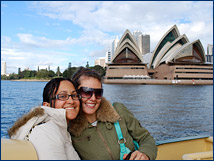 |
 |
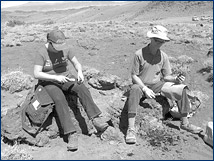 |
 |
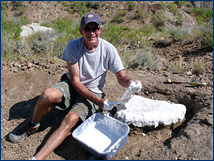 |

Left: Liz Ferrer and Jessie Atterholt cruise Sydney harbor. Middle: Lenny Kouenberg (left) is caught "knapping" — a technique used to shape tools and arrowheads from pieces of chert, flint or obsidianóduring a conference field trip in California. Right: Mark Goodwin applies a burlap and plaster jacket to a disarticulated subadult Triceratops skull he found in the Hell Creek Formation of eastern Montana this summer. |
Carole Hickman managed to combine both research and cuisine during her summer travels. At the joint annual meeting of the American Malacological Society and Western Society of Malacologists in San Diego, she presented a paper in the paleontology symposium and also delivered a tribute to Pacific Coast paleontologist LouElla Saul. But then Carole traveled to Phuket, Thailand, to give the opening lecture in a symposium at the World Congress of Malacology. She also conducted a survey of local biota at Phuket fresh market, where the shelled marine biota was well represented by live gastropods, bivalves, and lingulid brachiopods (the pedical of our beloved living fossil is considered a delicacy!) and the terrestrial biota were highlighted by mangosteens, rambutans, durian, dragon fruit, and mountains of very hot red chili peppers.
Cindy Looy and Ivo Duijnstee found themselves on a very lucrative treasure hunt this summer. They traveled to the 121-year-old Museum für Naturkunde in former East Berlin in search of Pleuromeia sternbergii — a ~250 million-year-old quillwort and one of the few plant species that actually thrived during the aftermath of the end-Permian crisis, the largest mass extinction ever recorded. Hoping to see a rare specimen that revealed detailed leaf scars on the outside of the stem, they were amazed to find a huge number of Pleuromeia specimens. Most of these were collected in the 19th century and included a lot of reproductive material and leaves. Feeling like two little kids in a candy store, and photographing as much as possible, they now have the task ahead of incorporating these treasures into a new whole-plant reconstruction. For more details of their summer adventure, see their September blog.
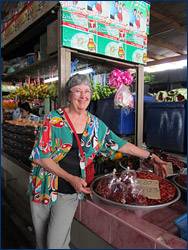 |
 |
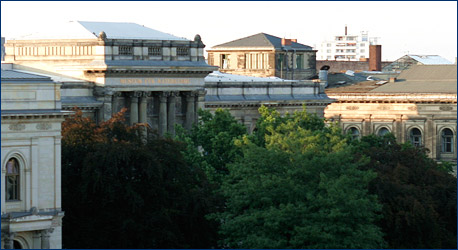 |

Left: Carole Hickman adds Thai chili peppers to her checklist of the Phuket biota. Right: Cindy Looy and Ivo Duinjnstee found "gold" in Berlin's Museum für Naturkunde. |
Oil spills are much in the news of late, but few of us probably recall the oil released 10 years ago from the sinking ship Erica or the oil from the Amoco Cadiz oil tanker wreck in 1978, both of which affected the biota in west and north Brittany. To examine the impact on living foraminifera, Jere Lipps, his postdoc Michele Weber, and French colleagues Drs. Marie-Thé Vénec-Peyré and Annachiara Bertolini of the Natural History Museum, Paris, spent two weeks collecting samples from marshes, salt farms and estuaries in that region. With funding from the France-Berkeley Fund, they sampled the marshes and salt ponds near Guerande to study the effects from the Erica and estuarine sediments at Le Dorduff to examine lingering effects of the oil, some 32 years after the spill occurred from the Amoco Cadiz.
Oil causes the foraminifera to make deformed shells that are commonly infested with turbellarian cysts or cocoons. Both deformed and infested shells increased in abundance, peaking within two years after the spills, but then returning to near normal abundances except for those with infestations that continued at higher than pre-spill occurrences. In the samples taken this summer from the Amoco Cadiz spill site, the deformed shells had returned to pre-spill percentages, while the infested shells remained higher than before. Whether or not the spilled oil is responsible for these seemingly lasting affects, is difficult to tell because current boating and near-shore activities still release some oil into the estuary. At the scale of small organisms that reproduce rapidly, the Amoco Cadiz spill probably has no lingering effects; however, longer-lived animals may still be impacted and the effects of an oil spill are variable at several short to long term levels depending on the life histories and habitats of the organisms.
Kaitlin Maguire spent her summer as a GeoCorps intern at the John Day Fossil Beds National Monument (JODA). This position, offered through the Geological Society of America, gives students and professionals the opportunity to work on public lands for three months. Throughout the summer, Kaitlin conducted fieldwork and research for her dissertation project. This included relocating fossil localities where previous UCMP members collected in the past, collecting specimens and rock samples, and finding new fossil localities. She also gained experience prepping, identifying and cataloguing fossils at the Thomas Condon Paleontology Center at JODA, and avoiding rattlesnakes.
For her fourth and final field season as a UCMP grad student, Erin Meyer traveled to Aruba, Panama, Costa Rica, and Mexico this summer to survey and collect tissue samples of Cittarium pica (West Indian Topshell). She now has a total of 1,346 tissue samples and habitat information for 7,445 individuals from 49 field sites in 24 island groups or countries. You can read all about her summer adventures and view several photographs on her personal blog. This fall, she will travel to Mo'orea, French Polynesia to teach a UC Berkeley undergraduate course titled "Biology and Geomorphology of Tropical Islands" (IB158LF).
Dave Smith spent a week in west central Nevada collecting fossils on behalf of UCMP. With UCMP Research Associate Des Maxwell of the University of the Pacific and field veterans Jay Grimaldi, Mark Lindner and Allison Gentry, Dave explored some known localities as well as some new ones. Trilobites were collected at localities in the vicinity of Goldfield and Goldpoint in Esmeralda County. With coordinates provided by Museum Scientist Diane Erwin, a number of plant localities west and north of Tonopah were visited. Near one of these, fossil leaf impressions were discovered in a soft, lightweight, white ash. By the end of the week, Dave and company had collected two boxes of fossils to be added to UCMP's collections.
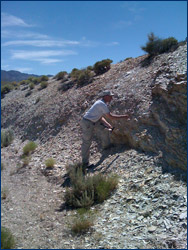 |
 |
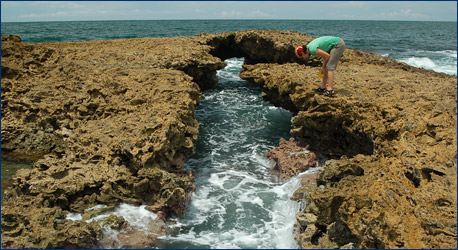 |

Left: Dave Smith looks for plant fossils at an outcrop of white shale in central Nevada. Right: Erin Meyer looks for Cittarium pica from a coral platform in Costa Rica. |
In mid-June Sarah Werning and Kevin Padian (along with UCMP alum, Drew Lee) went to Paris to give talks at the retirement symposium of Armand de Ricqles, who has been the leading light in fossil bone histology for the past 40 years. The symposium was very well attended and the program described as "terrific." On their return, they went out to Ghost Ranch, New Mexico, to join (or rejoin, in Sarah's case), the "UCMP" field crew (including alums Randy Irmis and Sterling Nesbitt) excavating the now-famous Hayden Quarry in the Late Triassic (Chinle Formation).






